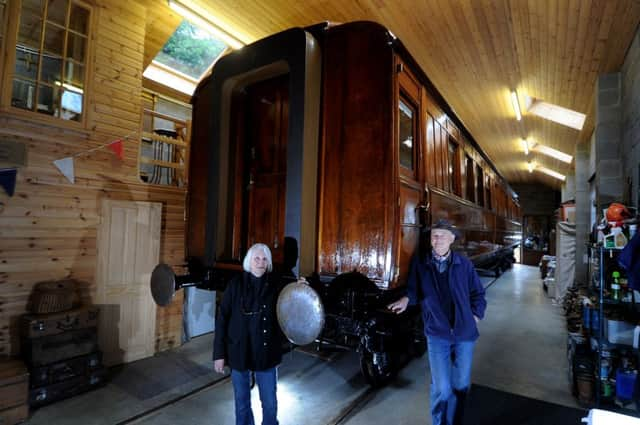The 25 year labour of love to restore a rare piece of railway history


Little did she imagine that more than 40 years later the carriage would become the focus of a very different journey when her husband, artist Michael Smith, took on a 25-year project to restore the storm-weathered sleeper.
Michael’s extraordinary labour of love is on-going: the beautiful piece of railway history rests on a purpose-built track in a private “shed” on the banks of the River Ouse, polished to perfection, luxuriously kitted out, every detail restored to the highest quality.
Advertisement
Hide AdAdvertisement
Hide Ad“I just couldn’t leave it behind,” says Michael. “So many carriages were deliberately destroyed or left to the elements, and I couldn’t bear to see that happen to this one.”
The East Coast Joint Stock First Class sleeper was one of just four of its kind, built in York in 1896. It ran between Kings Cross and Scotland and was considered to be the crème de la crème of overnight travel. When it was decommissioned in 1925 it was moved to Cayton Bay where it was used as holiday accommodation on a caravan park. Gloria’s father, Eric Otway, bought the site near Scarborough in 1949 and she and her brother would often sleep in one of the two twin compartments, or six singles, during weekends and holidays. Then Gloria and Michael took over the park in the early 1970s, running the business for 20 years until the time came to sell up and move.
“I was ready to leave the carriage behind, but Michael didn’t want to,” says Gloria. “My dad had always maintained that it had a Royal connection. It is quite elaborate and could have been used as a servants’ coach for one of the Royal trains.”
But how would they transport the 53ft coach body to a new location, and where would they store it so that it wasn’t left exposed to the weather? With typical practicality, Gloria and Michael bought a farmhouse in West Knapton where they ran a caravan dealership – with enough space for the carriage to be stored in an outbuilding. They hired a crane to lift it onto the back of a static caravan trailer, manoeuvred it into its new location and began the long, slow process of bringing it back to its former glory.
Advertisement
Hide AdAdvertisement
Hide Ad“I had seen one carriage set on fire and another destroyed with a JCB – to me it was sacrilege,” says Michael, a former art lecturer. ‘This carriage had been part of Gloria’s childhood and I just felt it deserved better.”
Michael began by cleaning years of tar off the roof with a heat gun, working two square feet per session, before stripping teak panels which had been damaged by time.
“I used metal plates, nuts and bolts and stainless steel to make the structure sound, then removed anything that wasn’t true to its origins,” he says. “I used new materials to create original styles and searched the length and breadth of the country to achieve it. We even managed to find an underframe, owned by a collector, which was the perfect fit.”
Michael’s attention to detail and perfectionism is at the core of the whole project. The wooden floors, for example, are made with 1.5ins thick pitch pine; the roof is repaired with purpose-made oak ribs inset with an iron band created by a local blacksmith and layered with hemp and Santex – a substitute for the original white lead; luggage racks have been recreated to Michael’s design and cast in brass; Lincrusta gilded decoration has been recreated and replaced where necessary and outside vents recast in iron. Doors have been recommissioned, wood panels polished until they gleam and Victorian furnishings used to recreate the plush interior – including original Pulman lamps bought in a sale.
Advertisement
Hide AdAdvertisement
Hide AdIn the past 25 years Gloria and Michael have moved house several times and each time they have found a location for the carriage. Today it sits in a purpose-built shed not far from highly acclaimed gastro-pub the Dawnay Arms at Newton-on-Ouse, which is run by their chef son Martel and his wife Kerry. Few people know it’s there – and Gloria and Michael prefer to keep it that way.
“There is still plenty to do,” says Michael. “I am still working on the luggage racks and I’ve been working on the internal panelling using an oil scumble process to create the patination based on the original. I feather the finish using a brush made with badger tail hairs. I have always worked to this degree of detail because I believe the integrity of the project is hugely important.”
Gloria and Michael cannot even begin to put a price on the cost of the restoration – they have simply saved and spent as they have gone along to do what they believe is necessary. ‘‘We often just come and sit inside the carriage to enjoy the peace and quiet, and soak up a little bit of history,” says Gloria. “Looking at it now, I can really appreciate it as a work of art. We just hope that one day someone will appreciate it as much as we do. We are just custodians of it at the end of the day.”